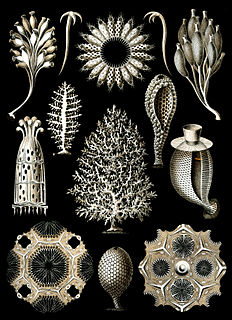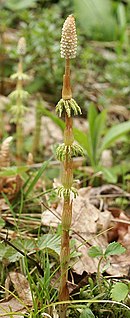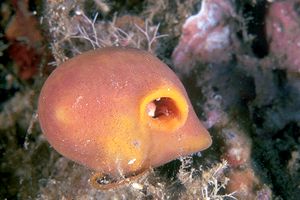
The Acantharea (Acantharia) are a group of radiolarian protozoa, distinguished mainly by their strontium sulfate skeletons. Acantharians are heterotrophic marine microplankton that range in size from about 200 microns in diameter up to several millimeters. Some acantharians have photosynthetic endosymbionts and hence are considered mixotrophs.

Sponges, the members of the phylum Porifera, are a basal Metazoa (animal) clade as a sister of the Diploblasts. They are multicellular organisms that have bodies full of pores and channels allowing water to circulate through them, consisting of jelly-like mesohyl sandwiched between two thin layers of cells. The branch of zoology that studies sponges is known as spongiology.

Hexactinellid sponges are sponges with a skeleton made of four- and/or six-pointed siliceous spicules, often referred to as glass sponges. They are usually classified along with other sponges in the phylum Porifera, but some researchers consider them sufficiently distinct to deserve their own phylum, Symplasma. Some experts believe glass sponges are the longest-lived animals on earth; these scientists tentatively estimate a maximum age of up to 15,000 years.

A sclerite is a hardened body part. In various branches of biology the term is applied to various structures, but not as a rule to vertebrate anatomical features such as bones and teeth. Instead it refers most commonly to the hardened parts of arthropod exoskeletons and the internal spicules of invertebrates such as certain sponges and soft corals. In paleontology, a scleritome is the complete set of sclerites of an organism, often all that is known from fossil invertebrates.

The polycystines are a group of radiolarians. They include the vast majority of the fossil radiolaria, as their skeletons are abundant in marine sediments, making them one of the most common groups of microfossils. These skeletons are composed of opaline silica. In some it takes the form of relatively simple spicules, but in others it forms more elaborate lattices, such as concentric spheres with radial spines or sequences of conical chambers.

The calcareoussponges of class Calcarea are members of the animal phylum Porifera, the cellular sponges. They are characterized by spicules made out of calcium carbonate in the form of calcite or aragonite. While the spicules in most species have three points, in some species they have either two or four points.

Equisetum sylvaticum, the wood horsetail, is a horsetail native to the Northern Hemisphere, occurring in North America and Eurasia. Because of its lacy appearance, it is considered among the most attractive of the horsetails.

Calcaronea is a subclass of sea sponges in the class Calcarea. They are Calcarea with the triactines and the basal system of tetractines sagittal, exceptionally regular. In ontogeny the first spicules to be secreted are diactines. Choanocytes are apinucleate. Calcaronea have amphiblastula larvae

Suberites domuncula is a species of sea sponge belonging to the family Suberitidae.
The United States Marine Raider stiletto was a stiletto issued to the Marine Raiders and 1st Canadian Parachute Battalion during World War II.

Sponge reefs are reefs formed by Hexactinellid sponges, which have a skeleton made of silica, and are often referred to as glass sponges. Such reefs are now very rare, and found only on the western Canadian continental shelf. Although common in the late Jurassic period, sponge reefs were believed to have gone extinct during or shortly after the Cretaceous period, until the existing reefs were discovered in 1987–1988 - hence these sometimes being dubbed living fossils.

Homosclerophorida is an order of marine sponges. It is the only order in the monotypic class Homoscleromorpha. The order is composed of two families: Plakinidae and Oscarellidae.

Spicules are structural elements found in most sponges. They provide structural support and deter predators. Large spicules that are visible to the naked eye are referred to as megascleres, while smaller, microscopic ones are termed microscleres. The meshing of many spicules serves as the sponge’s skeleton and thus it provides structural support and defense against predators. The composition, size, and shape of spicules is one of the largest determining factors in sponge taxonomy.

Carterinida is an order of multi-chambered foraminifera within the Globothalamea. Members of this order form hard tests out of thin calcite rods known as spicules, which are held together by a proteinaceous matrix.
Caryophyllidia are an anatomical feature of the external dorsal surface of dorid sea slugs. Caryophyllidia are sensory tubercles, surrounded by tiny needle-like structures called spicules, that are present on the outer mantle.

Agelas is a genus of sea sponge in the class Demospongiae.

Plexaurella is a genus of gorgonian-type octocorals in the family Plexauridae. Species of the genus are typically characterised by their slit-pores, however, there are some which lack this distinguishing feature. Sclerite examination is necessary for species identification, which reveals the characteristic 4-rayed 'butterfly' spicules of the cortex and the lack of purple sclerites in the axial sheath.

Pyura pachydermatina is a sea tulip, a solitary species of tunicate in the suborder Stolidobranchia. It is native to shallow waters around New Zealand.

Diaphorodoris mitsuii is a species of sea slug, a dorid nudibranch, a shell-less marine gastropod mollusc in the family Calycidorididae.

Verongiida is an order of sea sponges within the phylum Porifera. The "skeleton" in these sponges is made up of spongin, rather than of spicules. They live in marine environments. The name was proposed by Patricia Bergquist in 1978.















